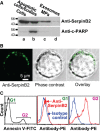Tumor cell-expressed SerpinB2 is present on microparticles and inhibits metastasis
- PMID: 24644264
- PMCID: PMC4101741
- DOI: 10.1002/cam4.229
Tumor cell-expressed SerpinB2 is present on microparticles and inhibits metastasis
Abstract
Expression of SerpinB2 (plasminogen activator inhibitor type 2/PAI-2) by certain cancers is associated with a favorable prognosis. Although tumor-associated host tissues can express SerpinB2, no significant differences in the growth of a panel of different tumors in SerpinB2(-/-) and SerpinB2(+/+) mice were observed. SerpinB2 expression by cancer cells (via lentiviral transduction) also had no significant effect on the growth of panel of mouse and human tumor lines in vivo or in vitro. SerpinB2 expression by cancer cells did, however, significantly reduce the number of metastases in a B16 metastasis model. SerpinB2-expressing B16 cells also showed reduced migration and increased length of invadopodia-like structures, supporting the classical view that that tumor-derived SerpinB2 is inhibiting extracellular urokinase. Importantly, although SerpinB2 is usually poorly secreted, we found that SerpinB2 effectively reaches the extracellular milieu on the surface of 0.5-1 μm microparticles (MPs), where it was able to inhibit urokinase. We also provide evidence that annexins mediate the binding of SerpinB2 to phosphatidylserine, a lipid characteristically exposed on the surface of MPs. The presence of SerpinB2 on the surface of MPs provides a physiological mechanism whereby cancer cell SerpinB2 can reach the extracellular milieu and access urokinase plasminogen activator (uPA). This may then lead to inhibition of metastasis and a favorable prognosis.
Keywords: Annexin; SerpinB2; metastasis; microparticle; phosphatidylserine.
© 2014 The Authors. Cancer Medicine published by John Wiley & Sons Ltd.
Figures






References
-
- Schroder WA, Major L, Suhrbier A. The role of SerpinB2 in immunity. Crit. Rev. Immunol. 2011;31:15–30. - PubMed
-
- Ye RD, Wun TC, Sadler JE. Mammalian protein secretion without signal peptide removal. Biosynthesis of plasminogen activator inhibitor-2 in U-937 cells. J. Biol. Chem. 1988;263:4869–4875. - PubMed
-
- Ritchie H, Booth NA. Secretion of plasminogen activator inhibitor 2 by human peripheral blood monocytes occurs via an endoplasmic reticulum-golgi-independent pathway. Exp. Cell Res. 1998;242:439–450. - PubMed
-
- Manders P, Tjan-Heijnen VC, Span PN, Grebenchtchikov N, Geurts-Moespot A, van Tienoven DT, et al. Complex of urokinase-type plasminogen activator with its type 1 inhibitor predicts poor outcome in 576 patients with lymph node-negative breast carcinoma. Cancer. 2004;101:486–494. - PubMed
Publication types
MeSH terms
Substances
LinkOut - more resources
Full Text Sources
Other Literature Sources
Molecular Biology Databases
Miscellaneous

